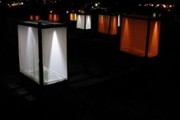 2017-01-10
2017-01-10
Artificial light at night is a threat to astronomical research, personal safety, and the health of both humans and wildlife. The problem is worsening with the proliferation of LED billboards and blue-rich white light LEDs as an option for street lighting. Within five years, LED technology will take over as the dominant type of outdoor lighting technology. With this in mind, scientists and lighting engineers say now is the time to implement strategies for reducing light pollution. By working together, they are identifying the best type of LED to use while suggesting actions that minimize intrusive lighting.
Continue reading →
 2016-08-09
2016-08-09
LED lighting manufacturer Evluma has received the IDA (International Dark Sky Association) Fixture Seal of Approval for its 40W and 70W 3000K CCT LED AreaMax street and area lights. IDA's Fixture Seal of Approval program certifies outdoor lighting fixtures as being Dark Sky Friendly, meaning that they minimize glare while reducing light trespass and skyglow. Certification criteria includes a CCT of 3000K or below and a U0 rating, emitting no light above 90 degrees. Street and area light submittals must also identify an optional backlight shield, available for the AreaMax since 2015.
Continue reading →
2016-06-30
University of Exeter completed a study that dates over 13 years, recording the budding. Researchers cross-referenced the data collected by volunteers. Meanwhile, night-time satellite images are also studied to understand the light pollution level in different areas, reported Dainly Mail.
Continue reading →
 2016-06-13
2016-06-13
New research from scientists show 80% of the world population is subjected to some form of light pollution, especially among the developed nations, reported Scientist. Authors of the paper also found LEDs contributed significantly to nighttime light pollution, please see below the full press release.
Continue reading →
 2015-03-17
2015-03-17
Artificial night time light from sources such as street lamps affects the growth and flowering of plants and even the number of insects that depend on those plants for food, a study published today confirms.
Continue reading →
 2017-01-10
2017-01-10
 2016-08-09
2016-08-09
 2016-06-13
2016-06-13
 2015-03-17
2015-03-17